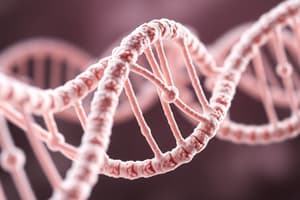Podcast
Questions and Answers
What role does base stacking play in DNA structure?
What role does base stacking play in DNA structure?
- Initiating the process of gene expression
- Determining the DNA sequence
- Maintaining the overall stability of the DNA double helix (correct)
- Promoting protein synthesis
Which type of base pairs exhibit the strongest interactions in DNA?
Which type of base pairs exhibit the strongest interactions in DNA?
- G|C
- G|A (correct)
- C|T
- T|A
How do pyrimidine-pyrimidine base pairs contribute to DNA structure?
How do pyrimidine-pyrimidine base pairs contribute to DNA structure?
- Initiate gene expression
- Act as a template for protein synthesis
- Form the backbone of the DNA molecule
- Enhance the stability of the DNA double helix (correct)
What is the significance of nonpolar surfaces of DNA bases?
What is the significance of nonpolar surfaces of DNA bases?
In high-throughput single-molecule experiments, what has been revealed about base stacking interactions?
In high-throughput single-molecule experiments, what has been revealed about base stacking interactions?
How do differences in base stacking interactions contribute to DNA structure?
How do differences in base stacking interactions contribute to DNA structure?
What are the two primary factors that maintain the stability of the DNA double helix?
What are the two primary factors that maintain the stability of the DNA double helix?
What is the role of base pairing in maintaining DNA stability?
What is the role of base pairing in maintaining DNA stability?
In DNA replication, what is the result of copying each parental strand?
In DNA replication, what is the result of copying each parental strand?
What do the nonpolar surfaces of DNA bases refer to?
What do the nonpolar surfaces of DNA bases refer to?
Which type of interaction contributes to the overall stability of DNA alongside base stacking?
Which type of interaction contributes to the overall stability of DNA alongside base stacking?
How do the major and minor grooves of DNA impact interactions with proteins?
How do the major and minor grooves of DNA impact interactions with proteins?
Flashcards are hidden until you start studying
Study Notes
Molecular Biology: The Role of Base Stackings and Interactions in DNA Structure
Molecular Biology is a field that revolves around understanding the physical and chemical aspects of biological macromolecules such as DNA and RNA. The study of these intricate systems has led to significant advancements in various biological processes, including gene expression, protein synthesis, and the evolution of life itself. One key aspect of this field is the investigation of the molecular interactions within DNA, specifically focusing on base stacking, double helix stability, and nonpolar surfaces of DNA bases.
Base Stacking in DNA Structure
Base stacking refers to the interaction between the nucleotide bases in a DNA molecule. It plays a crucial role in maintaining the overall stability of the DNA double helix. High-throughput single-molecule experiments have revealed that base stacking interactions between adjacent bases are essential for many biological processes and can even influence the stability of DNA nanostructures. The strength of these interactions varies depending on the type of base pairs involved. Purine-purine base pairs (G|A) exhibit the strongest interactions, while pyrimidine-pyrimidine base pairs (C|T) display the weakest. Such differences in base stacking contribute to the structure and stability of DNA, highlighting its importance in molecular biology.
Double Helix Stability
The stability of the DNA double helix is maintained by two primary factors: base pairing between complementary strands and stacking between adjacent bases. Base pairing ensures that the two strands of a DNA molecule are perfectly complementary, with A always pairing with T and G with C. Stacking between adjacent bases helps to maintain the integrity of the double helix by creating a three-dimensional structure that holds the sugar-phosphate backbones an equal distance apart along the DNA molecule. Both base pairing and stacking are necessary for maintaining the stability of DNA under various environmental conditions, including changes in temperature and salinity.
Interactions Between DNA Bases
Interactions between DNA bases are not limited to base stacking alone. There are also electrostatic interactions and hydrogen bonding that occur in DNA, contributing to its overall stability. For instance, researchers have shown that during DNA replication, each strand is copied, resulting in a daughter DNA double helix containing one parental DNA strand and a newly synthesized strand. This process relies on the complementary nature of base pairing, which ensures that each strand contains enough information to act as a template for the synthesis of the other.
Nonpolar Surfaces of DNA Bases
The nonpolar surfaces of DNA bases refer to the parts of the nucleotide molecules that do not interact with water or other polar solvents. These regions play a significant role in maintaining the overall structure of DNA and facilitating its interaction with various proteins and other macromolecules. For example, the major and minor grooves of DNA may determine which sequences are visible to DNA interacting proteins. Understanding these interactions between DNA bases and their surrounding environment can provide insights into the molecular mechanisms of gene expression, protein synthesis, and many other biological processes.
In conclusion, the intricate connections between base stacking, double helix stability, and interactions between DNA bases are essential aspects of molecular biology. By understanding these fundamental principles, researchers can gain valuable insights into the workings of life at the molecular level, leading to advancements in fields such as medicine, genetics, and biotechnology.
Studying That Suits You
Use AI to generate personalized quizzes and flashcards to suit your learning preferences.





